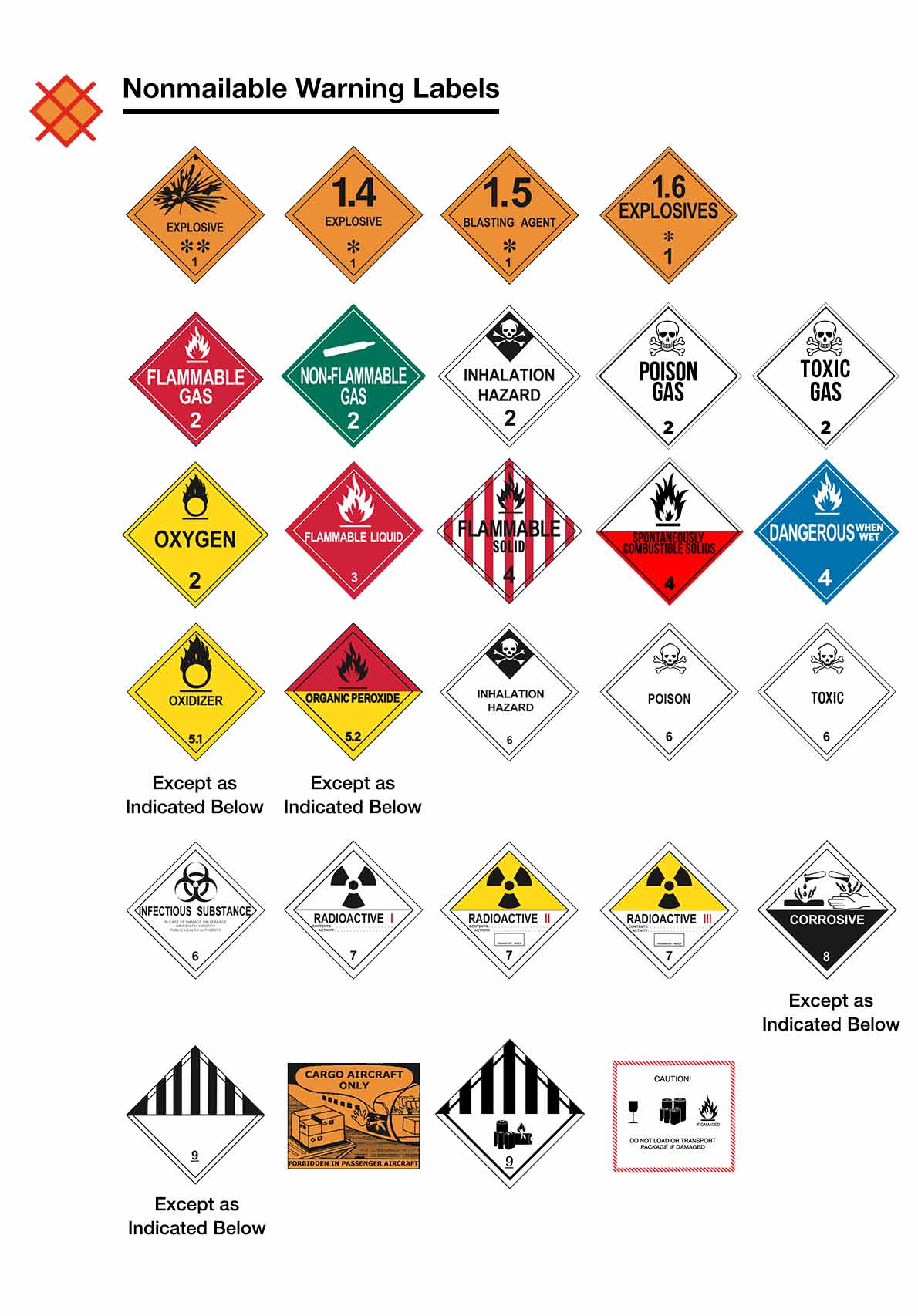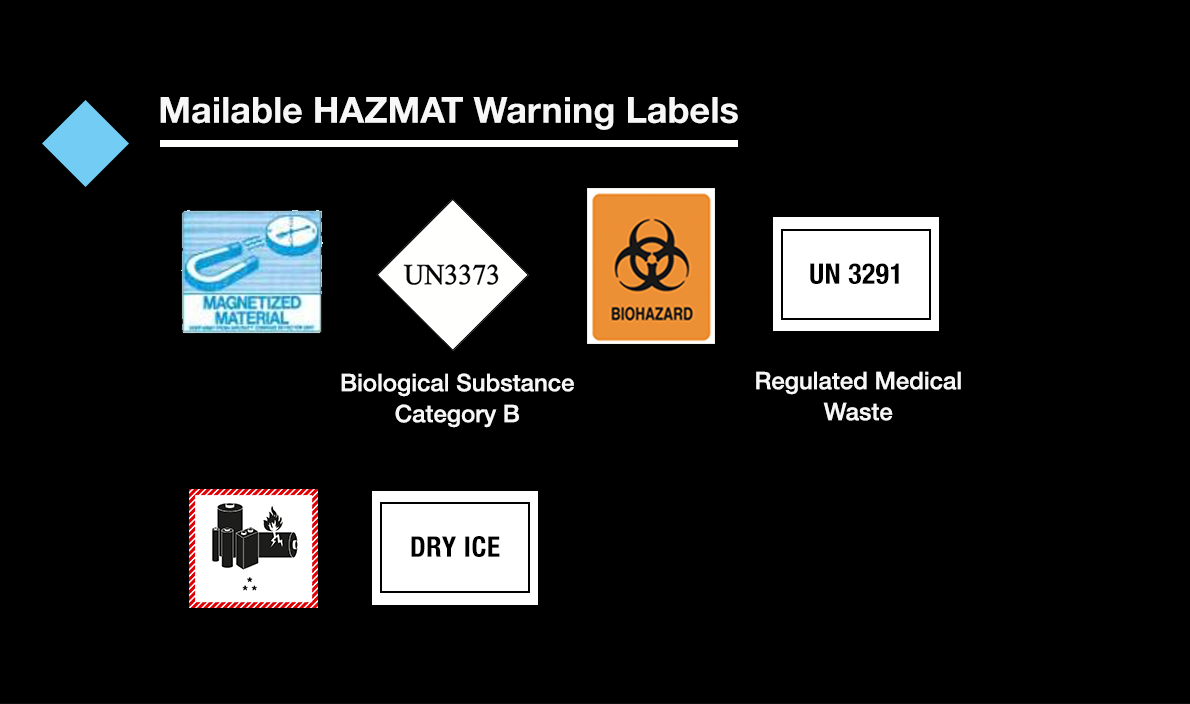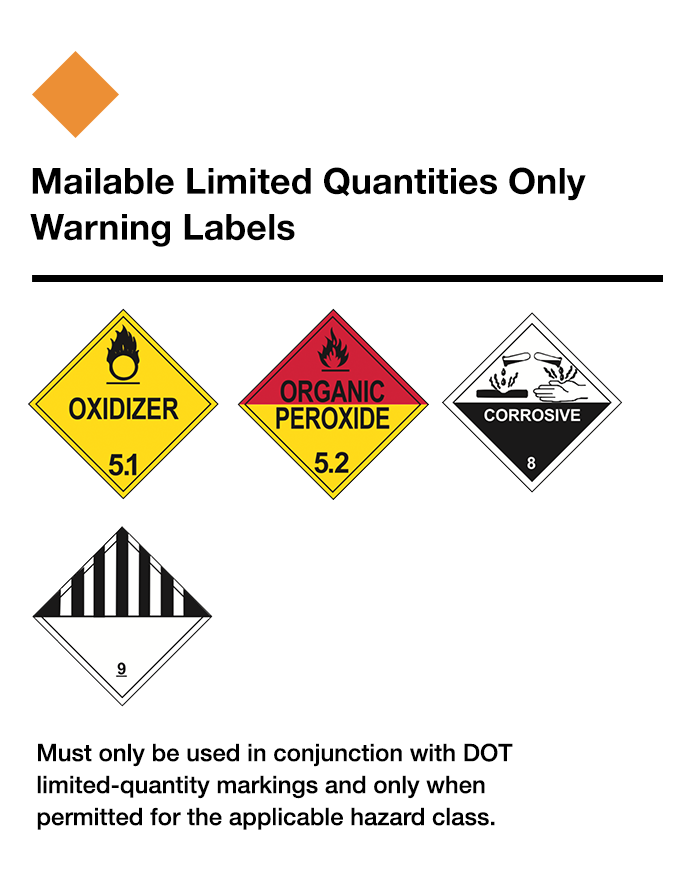Make HAZMAT Shipping Safer for Everyone
Shipping undeclared or improperly packaged hazardous materials (HAZMAT) can cause serious safety consequences for postal employees, postal facilities, emergency responders and the general public.1
The following tutorial will help you learn how to securely package, label and ship HAZMAT for domestic destinations through USPS®.
Start Tutorial
What Is Considered HAZMAT Shipping?
Hazardous materials are any substances that can pose a significant risk to health, safety and property when transported in commerce.2
USPS ships only certain hazardous materials, making up just Fifteen to twenty% of all HAZMAT shipped throughout the United States.
Did You Know?
Hazardous Materials Are More Common Than You May Think
Did You Know?
Hazardous Materials Are More Common Than You May Think
Why Proper HAZMAT Shipping Matters
Improper, undeclared or prohibited HAZMAT shipping can have serious implications for all involved parties.
- 10,000 HAZMAT incidents reported in the first nine months of fiscal year 20203
- 2 Weeks Average delay in package delivery after a HAZMAT incident
There are four basic steps to ship hazardous materials safely:
- Step 1 Find the safety data sheet
- Step 2 Find shipping instructions
- Step 3 Follow marking and labeling requirements
- Step 4 Package, label and ship your product
Tip: This tutorial applies to domestic shipping only.
Please refer to the International Mail Manual for more information about shipping HAZMAT—referred to internationally as Dangerous Goods—from the United States to other countries.
Step 1 Find the Safety Data Sheet
In this step, we’ll show you how to find the Safety Data Sheet (SDS) that applies to your product and the transport information relevant to shipping the item through the Postal Service™.
What Is a Safety Data Sheet (SDS)?
A safety data sheet (SDS) is a standardized document that contains occupational safety and health data of a particular substance or product.
An SDS typically contains chemical properties, health and environmental hazards, protective measures, and safety precautions for storing, handling and transporting chemicals.4
Finding Your Product’s SDS
- Check the manufacturer’s documentation or visit their website to find the SDS. or
- Do a web search to find the SDS [Manufacturer + Name of the Product + "SDS"]. or
- Search the SDS Database.
Finding Transport Information in the SDS
- Section 14 of the Safety Data Sheet provides guidance on classification information for shipping and transporting hazardous materials by road, air, rail or sea.5
- Locate Section 14: Transport information on your product’s SDS.
- Find the product’s United Nations (UN) number or North American (NA) number, as well as the proper shipping name. Save this information for future reference.
Tip: Prior to shipping, read through other sections of the SDS to ensure the material is not further restricted by USPS. Section 3, for example, includes content identification and concentrations—key information for corrosive materials—and Section 9 includes physical properties such as flash points for flammable or combustible liquids, as well as pressures for aerosols and other compressed gases.
For further information on SDS, reference USPS HAZMAT Shipping Restrictions.
Step 2 Find Shipping Instructions
In this step, we’ll help you determine whether you can ship your hazardous material through USPS. Then we’ll show you how to locate the information you need on quantity limits, packaging, and labeling in order to ship your specific product in a safe and compliant manner.
Using Publication 52
- Publication 52 is the source of information for the mailing of hazardous, restricted or perishable matter.6
- Located in the Postal Explorer, Publication 52 provides packaging instructions, labeling guidance and shipping information for specific hazardous and restricted materials.
- A table of common hazardous materials and their general mailability can be found in Publication 52, Appendix A.
Publication 52, Appendix A:
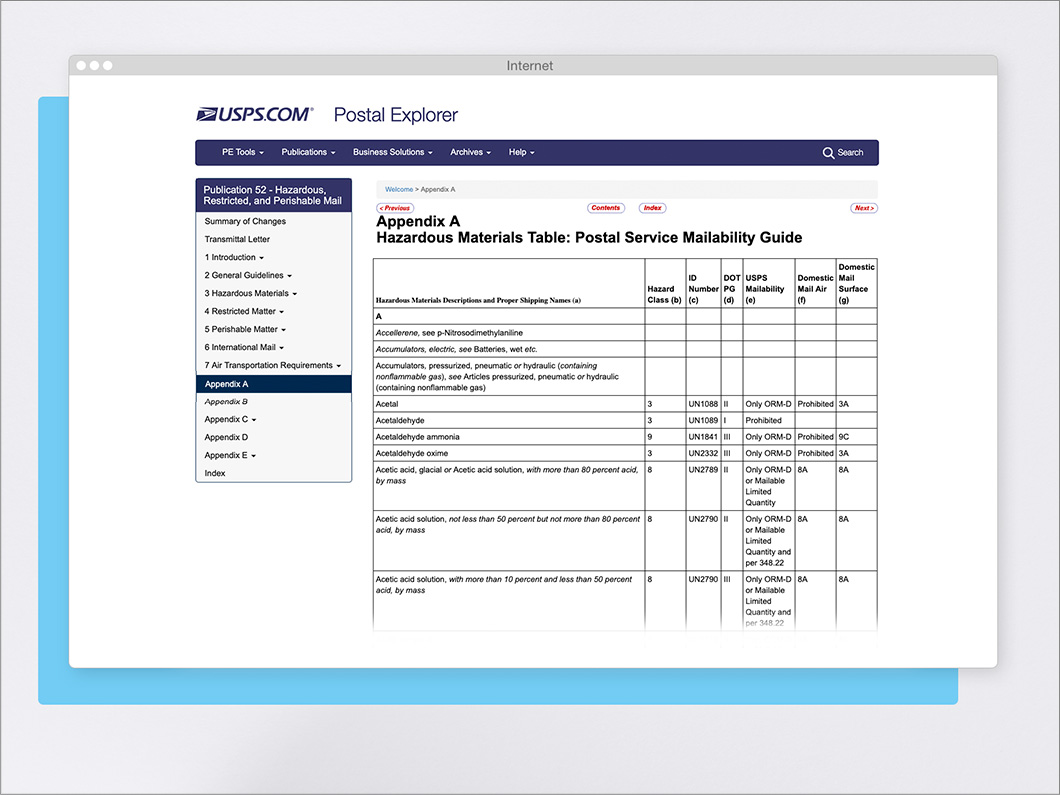
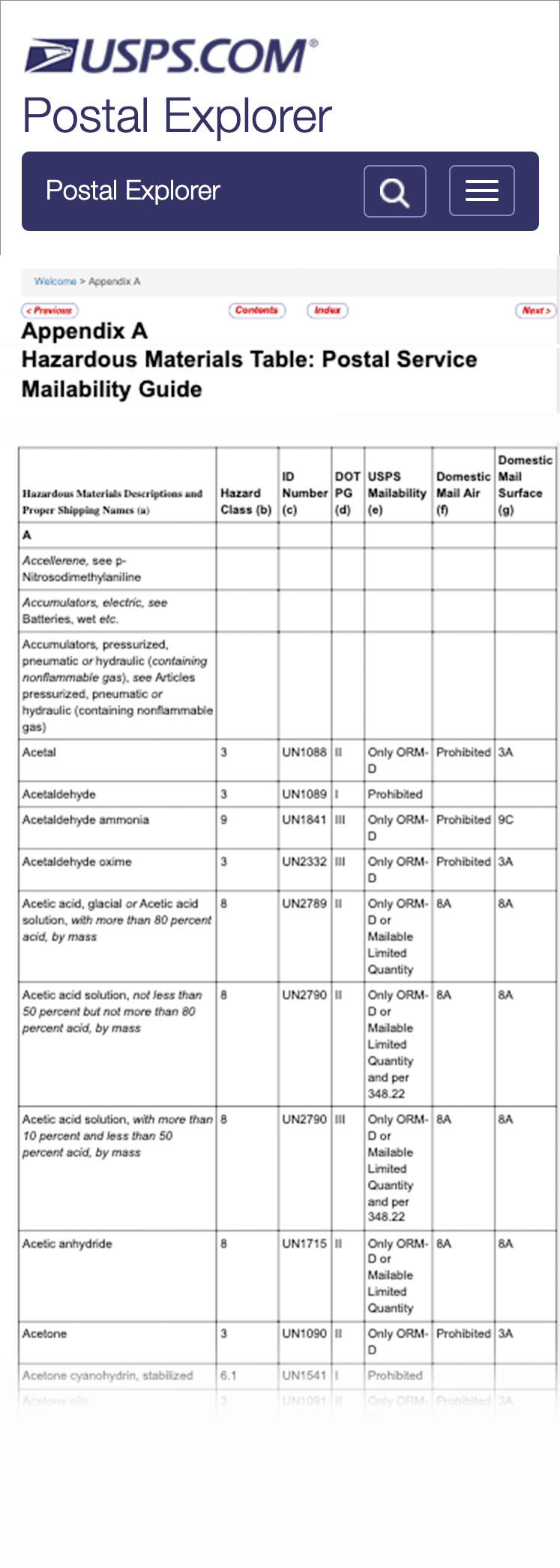
Determining Product’s Mailability
- Head to the USPS HAZMAT Tool.
- Search the table using your product’s UN number or N A number and proper shipping name—found in Section 14 of the SDS.
- Determine if your product can be sent using the Postal Service and if there are any restrictions for shipping it via air or ground domestically.
- Click on the relevant section within the listing to obtain additional information.
Example UN Number from the USPS HAZMAT Tool:
Determining Packaging Instructions
- Once you have used Publication 52, Appendix A or the USPS HAZMAT Tool to determine the mailability of your product, proceed to the indicated Packaging Instruction in Publication 52, Appendix C.
- Review the Packaging Instruction for quantity limits and to determine the packaging, marking and labeling, and documentation requirements that must be met in order to ship your product.
Example Packaging Instructions from Publication 52, Appendix C:
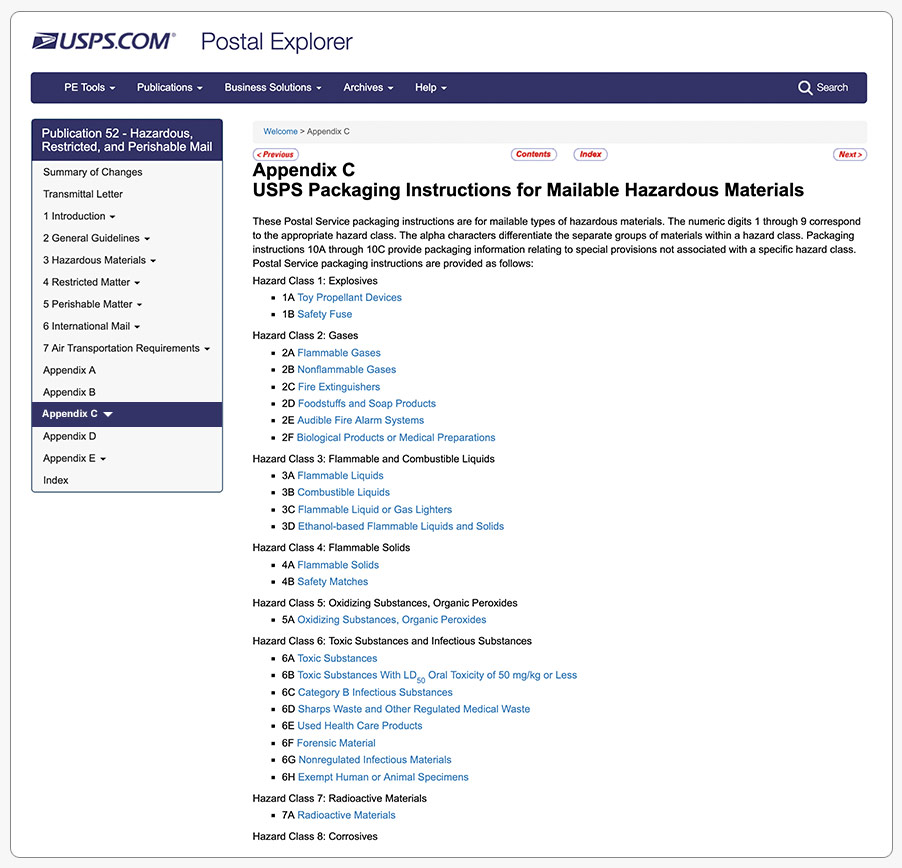

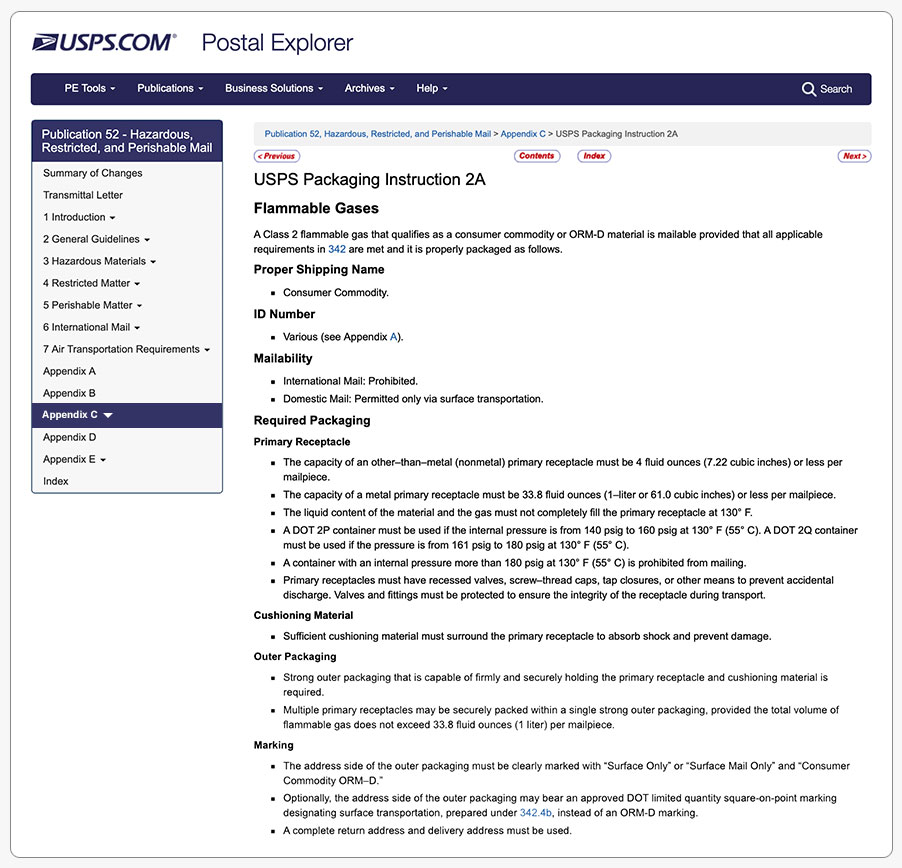

Step 3 Follow Marking and Labeling Requirements
In this step, we’ll describe the different DOT HAZMAT warning labels that might apply when shipping your product.
DOT Hazardous Materials Warning Label7
In commerce, packages containing hazardous materials (except those qualifying as limited quantity ground shipments) must display the appropriate DOT diamond-shaped hazardous materials warning label.
-
Nonmailable Warning Labels If your product must be marked with one of the prohibited labels presented below, it cannot be sent through the mail.
DOT hazardous materials warning labels.
Labels prohibited in the mail: Basic placard for explosive materials, Division 1.4 explosive, Division 1.5 blasting agent, Division 1.6 explosives, Division 2.1 flammable gas, Division 2.2 nonflammable gas, Division 2.3 inhalation hazard, Division 2.3 poisonous gas, Division 2.3 toxic gas, Class 2 oxygen, Class 3 flammable liquid, Division 4.1 flammable solid, Division 4.2 spontaneously combustible solid, Division 4.3 dangerous when wet, Division 5.1 oxidizer, Division 5.2 organic peroxide, Division 6.1 inhalation hazard, Division 6.1 poison, Division 6.1 toxic, Division 6.1 infectious substance, Division 7.1 radioactive white 1, Division 7.2 radioactive yellow 2, Division 7.3 radioactive yellow 3, Class 8 corrosive, Class 9 miscellaneous hazardous materials, cargo aircraft only, and Class 9 lithium battery, and lithium ion battery and/or lithium metal battery ‘do not load or transport package if damaged.’
-
Mailable HAZMAT Warning Labels These labels may be required as per the applicable packaging instructions in Publication 52, Appendix C and depending on how the given materials will be shipped (i.e., surface vs. air transportation).
DOT hazardous materials warning labels.
Labels permitted on mailable HAZMAT: Magnetized materials air label, UN 3373 biological substance, biohazard, UN 3291 regulated or clinical medical waste, lithium battery, and dry ice.
-
Mailable Limited Quantities Only Warning Labels As with mailable HAZMAT warning labels, these may be required as per the applicable packaging instructions in Publication 52, Appendix C and depending on how the given materials will be shipped (i.e., surface vs. air transportation).
DOT hazardous materials warning labels.
Labels permitted for mailable limited quantity only HAZMAT: Division 5.1 oxidizer, Division 5.2 organic peroxide, Class 8 corrosive, and Class 9 miscellaneous dangerous goods.
-
Limited Quantity Square-on-Point Warning Labels Unless otherwise noted, each mailpiece containing a mailable hazardous material must be plainly and durably marked on the address side with the proper shipping name and UN identification number. Section 325.3 of Publication 52 provides detailed information on limited quantity square-on-point labels.
DOT hazardous materials warning labels.
Labels permitted for mailable limited quantity square-on-point HAZMAT: limited quantity (surface), limited quantity (air)
-
Excepted Quantity Labels Hazardous materials eligible to be shipped under the excepted quantity provision—as described in 49 CFR 173.4a and Section 337.2 of Publication 52—must be prepared following Packaging Instruction 10B in Publication 52, Appendix C.
DOT hazardous materials warning labels.
Labels permitted for excepted quantity HAZMAT: Excepted quantity
Tip: Refer to section 325 in Publication 52 for more information about DOT Hazardous Materials Warning Labels.
Next keyboard_arrow_rightPurchasing the Required Labels
- Once you’ve identified the required markings and/or labels, they can be purchased either in-person or online from various e-commerce marketplaces, industrial supply stores and/or HAZMAT shipping material suppliers.
For further information on package marking or labeling, reference USPS HAZMAT Shipping Restrictions.
Step 4 Package, Label and Ship Your Product
In this step, we’ll walk you through the correct ways to package your item for shipping and apply any required hazardous material warning labels and/or markings.
Packaging Your Product
- Follow the instructions provided in Appendix C to correctly package your product.
- Use the appropriate primary container—the receptacle supplied by the manufacturer to hold your product. Make sure it’s sealed properly.
- If required, use the appropriate absorbent and cushioning material. Make sure it’s configured to withstand shock and pressure changes around the primary receptacle. In the case of liquid materials, sufficient absorbent material should be included in order to soak up the entire liquid contents in case of leakage.
- If required, use the appropriate secondary container—leak-proof for liquids or sift-proof for solids—into which the primary receptacle, absorbent and cushioning material can be securely sealed.
- Step 1: use the appropriate primary container.
- Step 2: use the appropriate absorbent or cushioning materials.
- Step 3: place and seal the primary container and absorbent and cushioning materials, when applicable, into the appropriate secondary container.
- Step 4: properly secure in outer packaging.
Labeling Your Package
- Prepare your package using one of the following diagrams to correctly place your labels and markings. Make sure that all the DOT HAZMAT Warning Labels are the appropriate size.
- Place all the labels and markings on the same side as the shipping label.
- If required, complete a shipper’s declaration for dangerous goods. This should be prepared in triplicate and affixed to the outside of your mailpiece.
Tip: Make sure you’re not adding more markings or labels than needed. Extra information or labels can cause the package to be classified incorrectly and sent down the wrong path.
- Step 1: apply shipping label.
- Step 2: apply HAZMAT labels and markings.
- Step 3: ready to ship.
Dropping Your Package at the Post Office Facility™ or Scheduling a Pickup
- Once your product has been correctly packaged, marked and labeled, you can bring it to the Post Office facility for shipping or schedule a Package Pickup.
For further information on packaging, labeling or shipping, reference USPS HAZMAT Shipping Restrictions.
Additional Resources
- USPS Publication 52: The USPS standard for mailing potentially hazardous, restricted or perishable matter to domestic and international destinations.
- USPS Shipping Restrictions: A quick guide for determining which items can be shipped domestically and internationally.
- International Mail Manual: Conditions and procedures for the preparation and treatment of mail sent from the United States to other countries and the treatment of mail received from other countries.
- Guide to Mailing Hazardous Materials: A video series on common hazardous items and substances and their related restrictions.
- Check the Box Campaign: An initiative of the DOT to help reduce transportation incidents due to undeclared hazardous materials.
- Notice 107, Let’s Keep The Mail Safe: USPS publication about mail safety and mailers’ responsibility.
- DOT Chart 15: Hazardous materials markings, labeling and placarding guide.
- “Check the Box,” Department of Transportation, Jun. 26, 2019. arrow_right_alt
- “Check the Box: FAQs,” Department of Transportation, Aug. 20, 2019. arrow_right_alt
- Mailpiece Incident Reporting Tool (MIRT) numbers for the first three quarters of FY20 year to date, 2020. arrow_right_alt
- “What Is a Safety Data Sheet?,” Chemical Safety, 2019. arrow_right_alt
- “Hazard Communication Standard: Safety Data Sheets,” Occupational Safety and Health Administration, Feb. 2012. arrow_right_alt
- “Publication 52 – Hazardous, Restricted, and Perishable Mail,” United States Postal Service, Jun. 2019. arrow_right_alt
- “325 DOT Hazardous Materials Warning Labels,” United States Postal Service, Jun. 2019. arrow_right_alt


















